
The Human Rights Act prohibits discrimination on the basis of race or other traits, including hairstyle. This law applies to employers as well as individuals. Protected characteristics include hair texture and type. In some cases, employers may restrict employees’ hairstyles as a way to prevent them from achieving professional success.
Historically, hairstyles have been used as a mark of identity for different ethnic groups and cultures. They have been used to signify age, social class, marital status, and tribal affiliation. Many still play a prominent role today, and many traditional hairstyles have been adapted by celebrities and others as fashion statements. Understanding the history of hairstyles can help us adopt a more respectful attitude toward people of different races and ethnicities.
Using styling products can make it easier to maintain a specific hairstyle. An undercut, for example, gives way to a side-swept hairstyle and a pompadour. Using a styling cream, hair wax, or hair spray can help you achieve a variety of looks. If you aren’t sure what look to go for, In Style has over 100 pictures of hairstyles. If you don’t want to go through all of these pictures, try narrowing your search by a particular celebrity or style.
In medieval China, hairstyles often reflected the status of people. For example, some women wore their hair up when they married. Some of them would use small amber ornaments to dress up their hair. Others might wear their hair in intricate geometric patterns. This hairstyle was introduced to mainland China by the Manchu people, an ethnic group from the Manchu region of China. These people later invaded the Ming Dynasty and took control of the capital, which created the Qing Dynasty that lasted from 1644 until 1912.
A good way to learn more about the history of the word “hairstyle” is by looking at the dictionary definition of the term “hairstyle”. It is also useful to check how frequently it is used in the English language. You can also use a free thesaurus to learn how to say the word. The Macmillan English Dictionary has more information.
When choosing a hairstyle, it is important to consider your lifestyle and the type of face your hair has. For example, if you have round or square-shaped face, a hairstyle with a high density could look a little strange on your face. For this reason, you should do a little research and experiment.
The Mullet hairstyle has been around for a while. In the early ’70s, Icelandic fishmongers cultivated this style to keep their necks dry and warm. It also has a history in the Palaces of Poland. Mullet comes from the word mulled, which means “to ponder.” The name also evokes the notion of intellectual pondering. Other names for the style include Kentucky Waterfall, Mississippi Top Hat, and Bouncing Cobra. In Germany, it is known as Vokuhila.